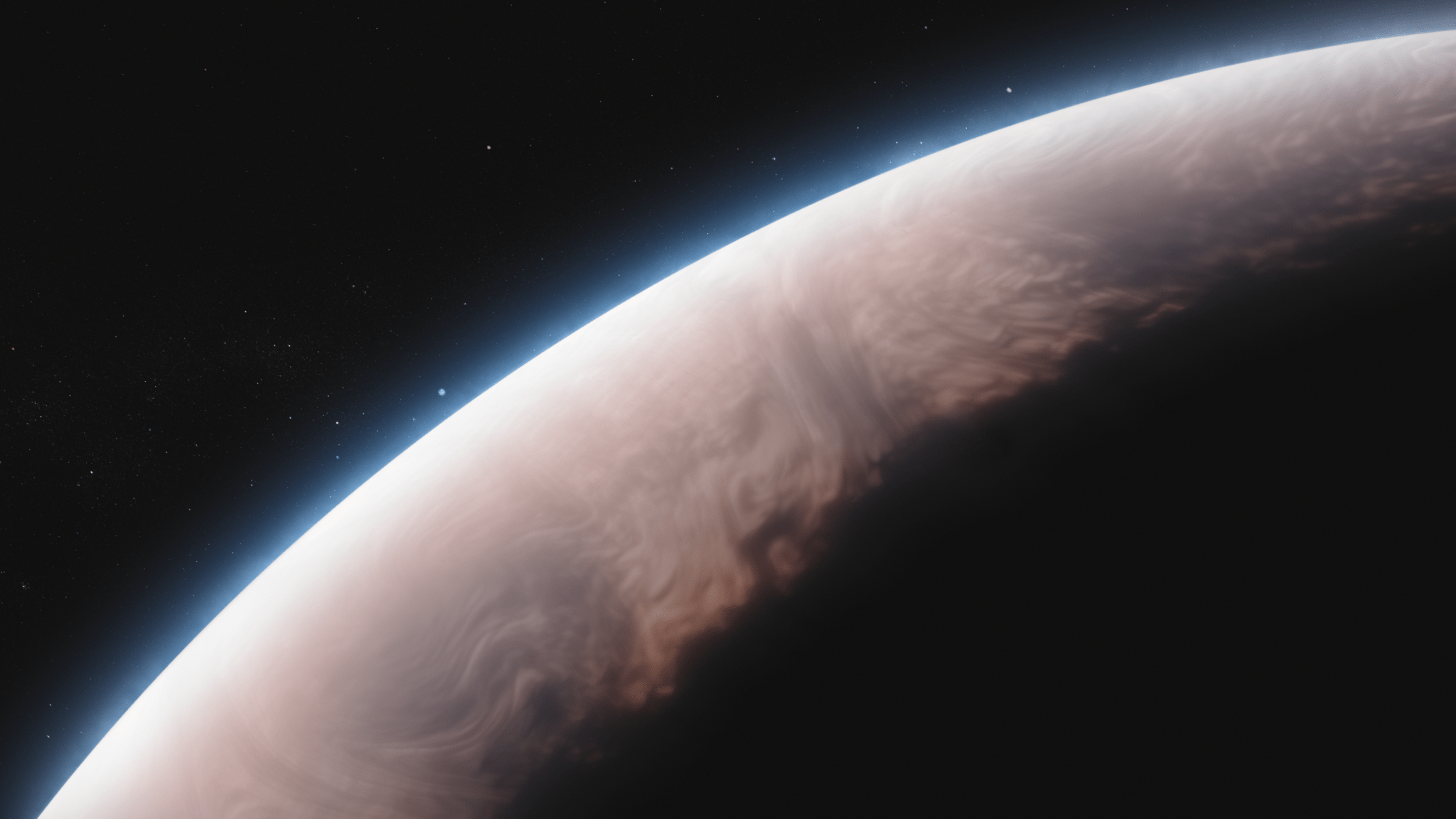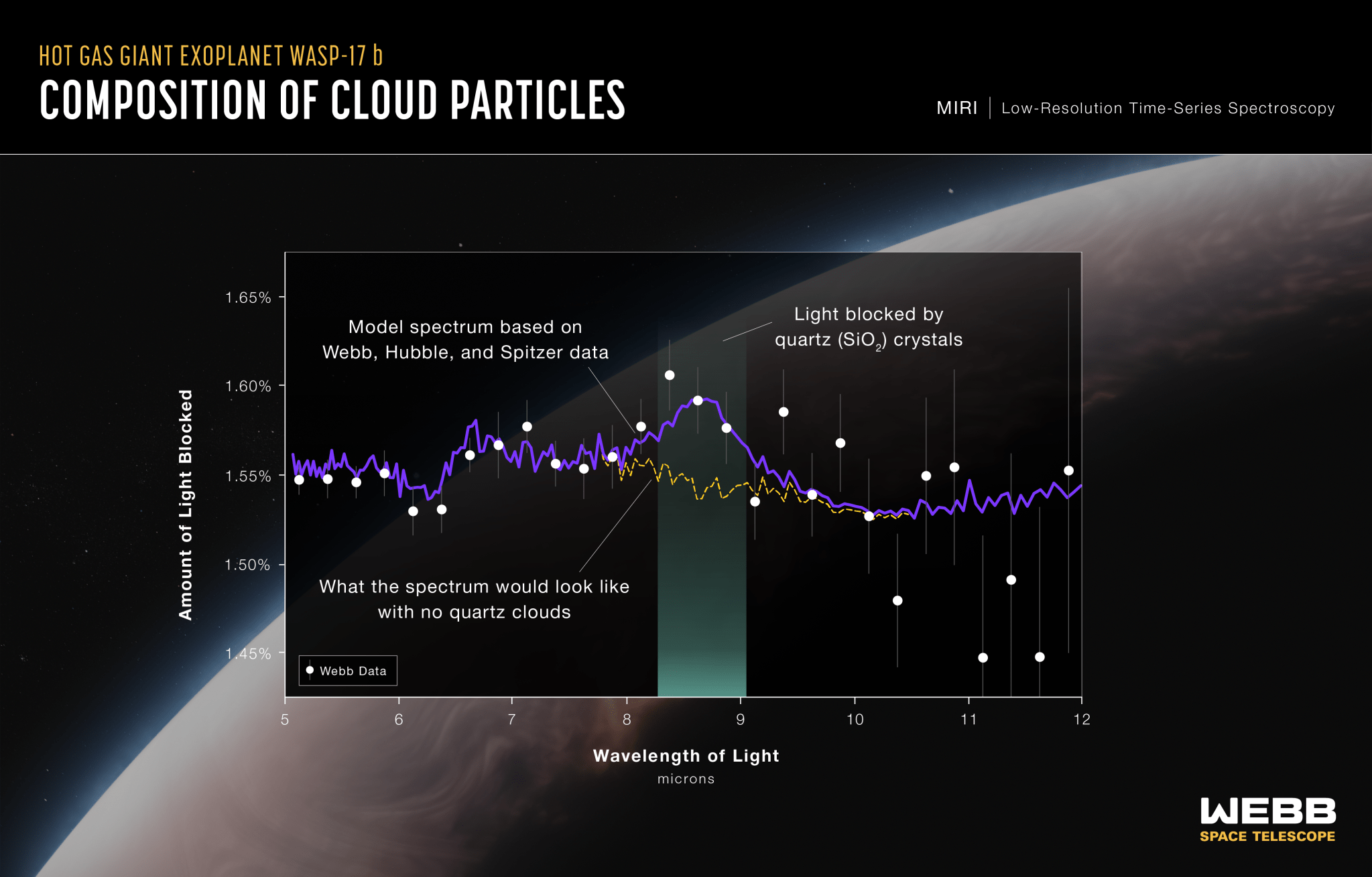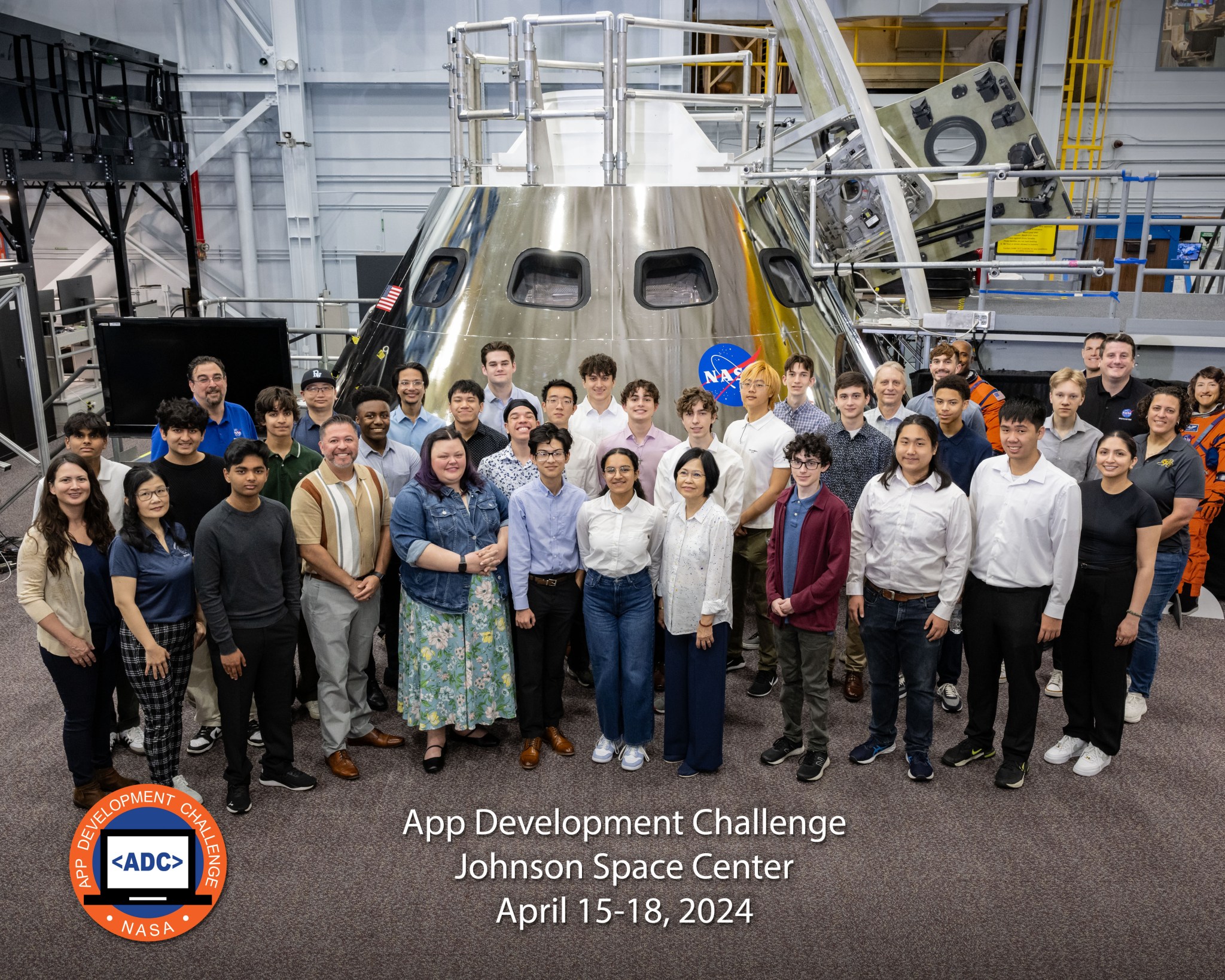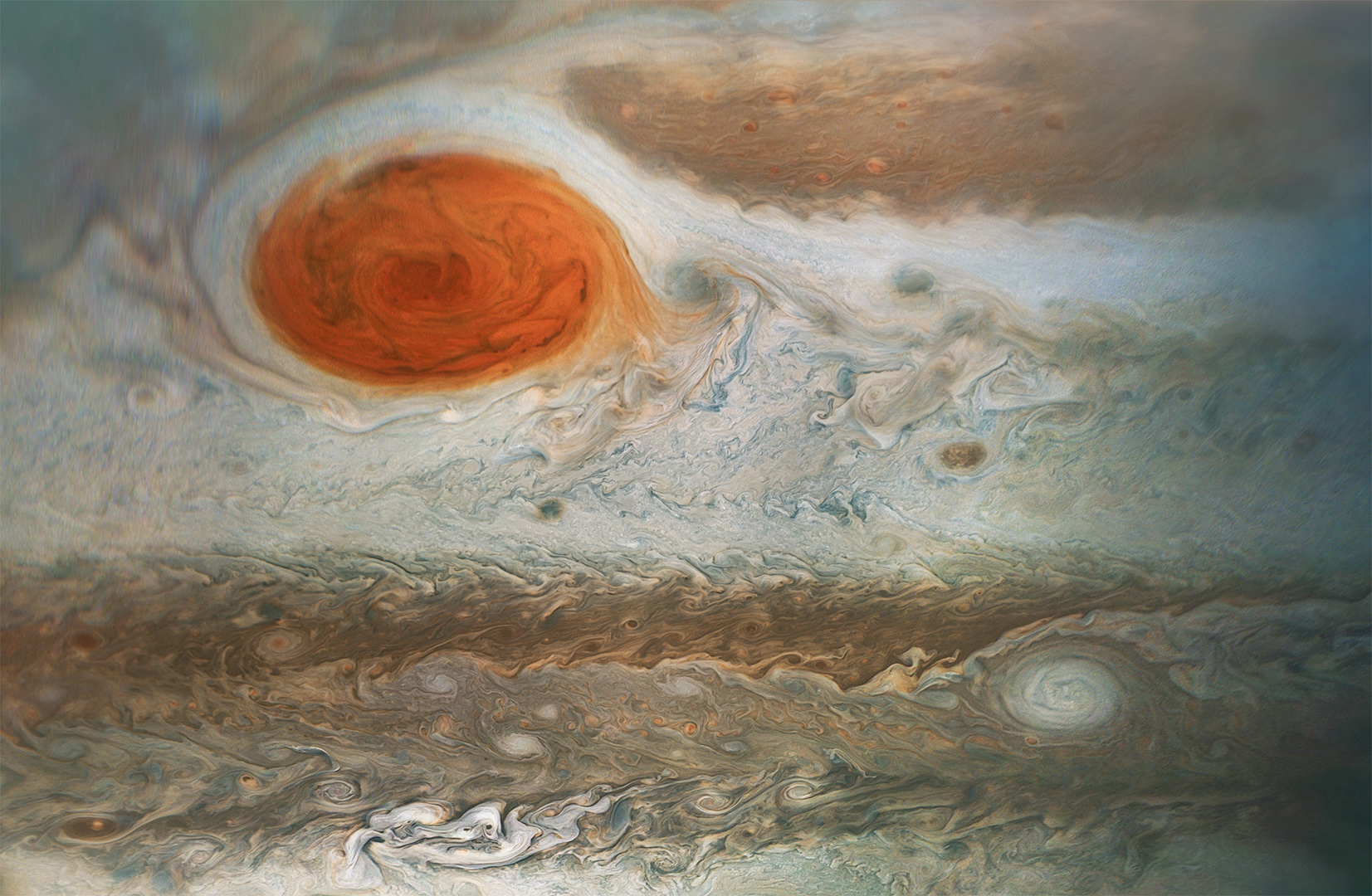
Researchers using NASA’s James Webb Space Telescope have detected evidence for quartz nanocrystals in the high-altitude clouds of WASP-17 b, a hot Jupiter exoplanet 1,300 light-years from Earth. The detection, which was uniquely possible with MIRI (Webb’s Mid-Infrared Instrument), marks the first time that silica (SiO2) particles have been spotted in an exoplanet atmosphere.

“We were thrilled!” said David Grant, a researcher at the University of Bristol in the UK and first author on a paper being published today in the Astrophysical Journal Letters. “We knew from Hubble observations that there must be aerosols—tiny particles making up clouds or haze—in WASP-17 b’s atmosphere, but we didn’t expect them to be made of quartz.”
Silicates (minerals rich in silicon and oxygen) make up the bulk of Earth and the Moon as well as other rocky objects in our solar system, and are extremely common across the galaxy. But the silicate grains previously detected in the atmospheres of exoplanets and brown dwarfs appear to be made of magnesium-rich silicates like olivine and pyroxene, not quartz alone – which is pure SiO2.
The result from this team, which also includes researchers from NASA’s Ames Research Center and NASA’s Goddard Space Flight Center, puts a new spin on our understanding of how exoplanet clouds form and evolve. “We fully expected to see magnesium silicates,” said co-author Hannah Wakeford, also from the University of Bristol. “But what we’re seeing instead are likely the building blocks of those, the tiny ‘seed’ particles needed to form the larger silicate grains we detect in cooler exoplanets and brown dwarfs.”
Detecting Subtle Variations
With a volume more than seven times that of Jupiter and a mass less than one-half Jupiter, WASP-17 b is one of the largest and puffiest known exoplanets. This, along with its short orbital period of just 3.7 Earth-days, makes the planet ideal for transmission spectroscopy : a technique that involves measuring the filtering and scattering effects of a planet’s atmosphere on starlight.
Webb observed the WASP-17 system for nearly 10 hours, collecting more than 1,275 brightness measurements of 5- to 12-micron mid-infrared light as the planet crossed its star. By subtracting the brightness of individual wavelengths of light that reached the telescope when the planet was in front of the star from those of the star on its own, the team was able to calculate the amount of each wavelength blocked by the planet’s atmosphere.
What emerged was an unexpected “bump” at 8.6 microns, a feature that would not be expected if the clouds were made of magnesium silicates or other possible high temperature aerosols like aluminum oxide, but which makes perfect sense if they are made of quartz.

The spectrum was made by measuring the change in brightness of 28 wavelength-bands of mid-infrared light as the planet transited the star. Webb observed the WASP-17 system using MIRI’s low-resolution spectrograph for nearly 10 hours, collecting more than 1,275 measurements before, during, and after the transit.
For each wavelength, the amount of light blocked by the planet’s atmosphere (white circles) was calculated by subtracting the amount that made it through the atmosphere from the amount originally emitted by the star.
The solid purple line is a best-fit model to the Webb (MIRI), Hubble, and Spitzer data. (The Hubble and Spitzer data cover wavelengths from 0.34 to 4.5 microns and are not shown on the graph.) The spectrum shows a clear feature around 8.6 microns, which astronomers think is caused by silica particles absorbing some of the starlight passing through the atmosphere.
The dashed yellow line shows what that part of the transmission spectrum would look like if the clouds in WASP-17 b’s atmosphere did not contain SiO2.
This marks the first time that SiO2 has been identified in an exoplanet, and the first time any specific cloud species has been identified in a transiting exoplanet.
Download full resolution images for this article from the Space Telescope Science Institute (STScI)
Crystals, Clouds, and Winds
While these crystals are probably similar in shape to the pointy hexagonal prisms found in geodes and gem shops on Earth, each one is only about 10 nanometers across—one-millionth of one centimeter.
“Hubble data actually played a key role in constraining the size of these particles,” explained co-author Nikole Lewis of Cornell University, who leads the Webb Guaranteed Time Observation (GTO) program designed to help build a three-dimensional view of a hot Jupiter atmosphere. “We know there is silica from Webb’s MIRI data alone, but we needed the visible and near-infrared observations from Hubble for context, to figure out how large the crystals are.”
Unlike mineral particles found in clouds on Earth, the quartz crystals detected in the clouds of WASP-17 b are not swept up from a rocky surface. Instead, they originate in the atmosphere itself. “WASP-17 b is extremely hot—around 1,500 degrees Celsius (2,700°F)—and the pressure where they form high in the atmosphere is only about one-thousandth of what we experience on Earth’s surface,” explained Grant. “In these conditions, solid crystals can form directly from gas, without going through a liquid phase first.”
Understanding what the clouds are made of is crucial for understanding the planet as a whole. Hot Jupiters like WASP-17 b are made primarily of hydrogen and helium, with small amounts of other gases like water vapor (H2O) and carbon dioxide (CO2). “If we only consider the oxygen that is in these gases, and neglect to include all of the oxygen locked up in minerals like quartz (SiO2), we will significantly underestimate the total abundance,” explained Wakeford. “These beautiful silica crystals tell us about the inventory of different materials and how they all come together to shape the environment of this planet.”
Exactly how much quartz there is, and how pervasive the clouds are, is hard to determine. “The clouds are likely present along the day/night transition (the terminator), which is the region that our observations probe,” said Grant. Given that the planet is tidally locked with a very hot day side and cooler night side, it is likely that the clouds circulate around the planet, but vaporize when they reach the hotter day side. “The winds could be moving these tiny glassy particles around at thousands of miles per hour.”
WASP-17 b is one of three planets targeted by the JWST-Telescope Scientist Team’s Deep Reconnaissance of Exoplanet Atmospheres using Multi-instrument Spectroscopy (DREAMS) investigations, which are designed to gather a comprehensive set of observations of one representative from each key class of exoplanets: a hot Jupiter, a warm Neptune, and a temperate rocky planet. The MIRI observations of hot Jupiter WASP-17 b were made as part of GTO program 1353.
The James Webb Space Telescope is the world’s premier space science observatory. Webb is solving mysteries in our solar system, looking beyond to distant worlds around other stars, and probing the mysterious structures and origins of our universe and our place in it. Webb is an international program led by NASA with its partners, ESA (European Space Agency) and the Canadian Space Agency.
Media Contacts:
Laura Betz
NASA’s Goddard Space Flight Center, Greenbelt, Md.
[email protected]
Christine Pulliam
Space Telescope Science Institute, Baltimore, Md.
[email protected]








